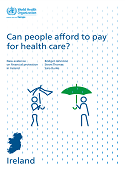Can people afford to pay for health care? New evidence on financial protection in Ireland (2020)

Download
By Bridget Johnston, Steve Thomas, Sara Burke
2020, xiii + 99 pages
ISBN 978 92 890 55086
This publication is only available online.
This review is part of a series of country-based studies generating new evidence on financial protection in health systems in Europe. Financial protection is central to universal health coverage and a core dimension of health system performance.
Although catastrophic spending on health in Ireland is low on average, reflecting one of the lowest levels of out-of-pocket payments in Europe, it has increased over time. Cuts to the health budget introduced in response to the 2008 financial crisis shifted health care costs on to households and are associated with increases in financial hardship and unmet need for health care and dental care, particularly among poor households.
The relatively low incidence of catastrophic health spending in Ireland can be attributed to the fact that almost all health services are free at the point of use for the poorest third of the population – an exemplary policy – and the presence of multiple protection mechanisms for people who do have to pay user charges, such as exemptions for people with chronic conditions and annual caps on co-payments for everyone.
Ireland’s large private health insurance market reduces exposure to out-of-pocket payments for specialist care, but it represents a significant financial burden on households. It also undermines equity and efficiency by allowing nearly half of the population to access health services on the basis of ability to pay rather than need.



